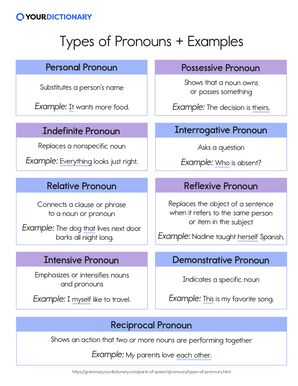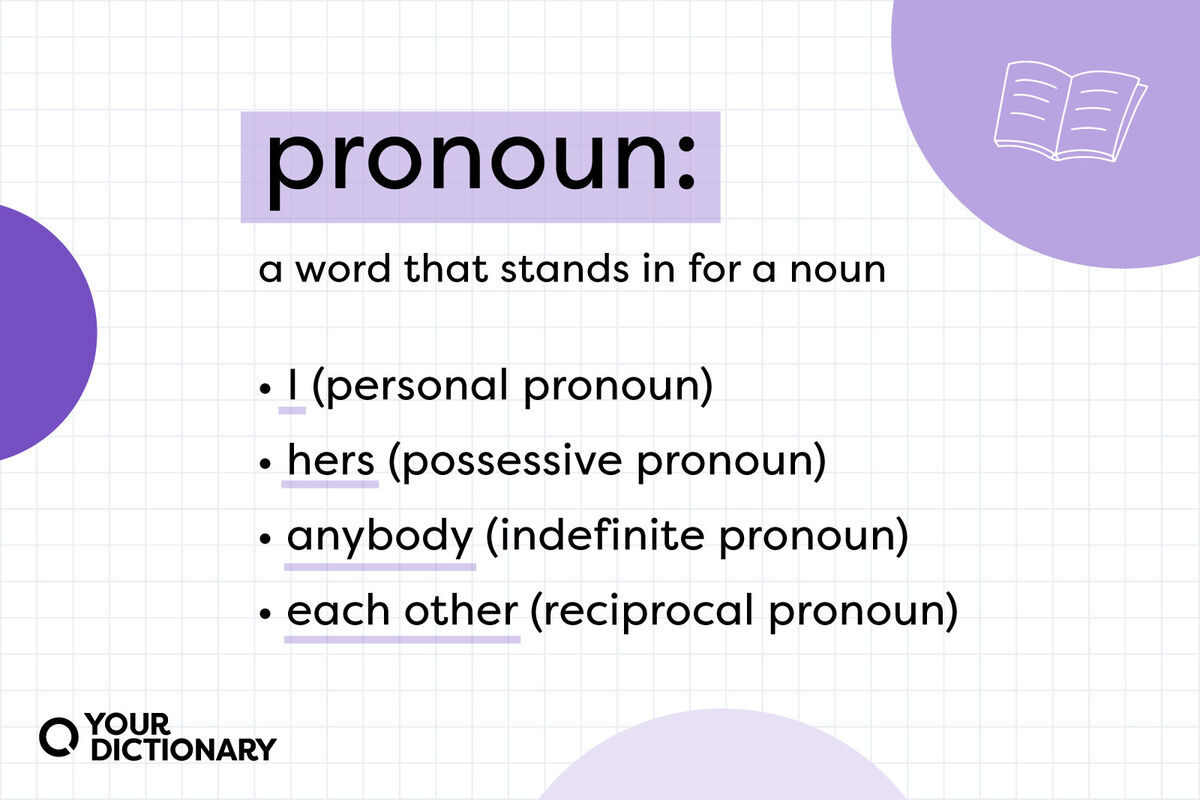

Pronouns replace nouns in a sentence. But these little words have big responsibilities — pronouns can name people or things, show ownership, ask questions, reciprocate meaning, and much more.
What Is a Pronoun?
A pronoun is one of the eight main parts of speech. The word pronoun means “on behalf of a noun,” meaning that it stands in for a noun (the antecedent) to avoid repetitive nouns in writing. For example:
- Carson went for a walk. It started to rain, so Carson went back to Carson’s house.
- Carson went for a walk. It started to rain, so he went back to his house.
- Lions live in packs. Lions work together to take care of lions’ cubs, and lions love to be with other lions.
- Lions live in packs. They work together to take care of their cubs, and they love to be with other lions.
Matching a pronoun with its antecedent is called noun-pronoun agreement. Make sure you’re choosing the correct pronoun based on the noun it’s replacing.
Examples of Pronouns
To know which pronoun you need, determine whether the noun you’re replacing is singular or plural, and if it’s referring to a first-person, second-person, or third-person noun.
- singular pronoun - refers to one noun
- plural pronoun - refers to more than one noun
- first person - speaking about yourself
- second person - speaking directly to another person
- third person - speaking about another person
Then you can use a list of pronouns to find the right options.
|
Singular Pronouns |
Plural Pronouns |
|
|
First Person Pronouns |
I, me, my, mine, myself |
we, us, our, ours, ourselves |
|
Second Person Pronouns |
you, your, yours |
you, your, yours |
|
Third Person Pronouns |
he, his, she, her, hers, it, its, *they, them, their, theirs |
they, them, their, theirs |
*The personal pronouns you use depend on the context of a sentence and a person's preferred pronouns. Many style guides now have guidance on using they/them as singular pronouns.
What Are the 9 Different Types of Pronouns?
Replacing nouns is just one part of a pronoun’s job. Depending on the type of pronoun, there’s a lot more for them to do in a sentence.

Personal Pronouns
Personal pronouns substitute a person's name. They can also substitute any third-person noun in a sentence.
Subject pronouns (I, you, he, she, it, we, they) function as the subject of a sentence.
- My family went to the store.
- They went to the store.
- The ostrich wants more food.
- It wants more food.
Object pronouns (me, you, him, her, it, us, them) replace the name of the object of a sentence.
- Go talk to Victoria.
- Go talk to her.
- Has anyone met Edgar?
- Has anyone met him?
Possessive Pronouns
Possessive pronouns (mine, yours, hers, his, its, ours, theirs) show that a noun owns or possesses something. They replace a noun that typically has an apostrophe and "S" after it (or just an apostrophe for plural nouns). But possessive pronouns do not need the apostrophe + "S" to show possession.
- That prize is Zoe’s.
- That prize is hers.
- The decision is the Hendersons’.
- The decision is theirs.
Possessive determiners (my, your, her, his, its, our, their) come before a noun to modify it, just like an adjective.
- That is Zoe’s prize.
- That is her prize.
- It’s the Hendersons’ decision.
- It’s their decision.
The two possessive pronouns that are the same in both cases are his and its — the words are spelled the same no matter how you use them as a pronoun (with no apostrophe in its).
Indefinite Pronouns
We use indefinite pronouns when a noun isn’t specific. Singular indefinite pronouns (anybody, anyone, anything, each, everybody, everyone, everything, little, much, nobody, no one, nothing, one, somebody, someone, something) function as singular pronouns with singular verbs.
- Everything looks just right.
- No one is helping.
- Each brings a gift.
Plural indefinite pronouns (both, few, many, several) function as plural nouns.
- Both look just right.
- Many are helping.
- Few bring a gift.
Some indefinite pronouns (all, any, more, most, none, some, such) function as both singular and plural.
- Most looks just right.
- None are helping.
- All bring a gift.
Most indefinite pronouns work whether the noun comes before the pronoun or not. However, clarifying the noun in the previous sentence may help with any misunderstanding.
Relative Pronouns
Relative pronouns connect a clause or phrase to a noun or pronoun. They add more information to a sentence.
Definite relative pronouns (who, whom, which, whose, that) refer to a specific noun, and are the first word in a noun clause.
- Find the man who stole the money.
- The watch, which turned out to be a fake, cost a lot of money.
- The dog that lives next door barks all night long.
Indefinite relative pronouns, also known as compound relative pronouns, are relative pronouns with -ever at the end (whoever, whomever, whichever, whatever). They describe general or unknown nouns.
- Thank whoever sent a gift.
- Whichever you choose will be great.
- We should watch whatever comes on next.
You can use relative pronouns to introduce adjective clauses. They connect dependent clauses to independent clauses to create a more thorough sentence.
Interrogative Pronouns
Interrogative pronouns (who, whom, which, what, whose, whoever, whomever, whichever, whatever) have the same form as relative pronouns, but they ask a question.
Like all pronouns, interrogative pronouns replace a noun. If they come before a noun, they’re interrogative determiners.
- Who is absent?
- Which is cheaper?
- Whatever do you mean?
It may seem like there are words missing from this list, such as where and why. However, they are not interrogative pronouns — they are adverbs that describe more about verbs.
Reflexive Pronouns
Reflexive pronouns replace the object of a sentence when it refers to the same person or item in the subject. Singular reflexive pronouns end in -self ((myself, yourself, himself, herself, itself, themself, theirself).
- You should buy yourself a smoothie.
- Nadine taught herself Spanish.
- The spider spun a web for itself.
Plural reflexive pronouns end in -selves (yourselves, ourselves, themselves).
- You should buy yourselves a smoothie.
- We taught ourselves Spanish.
- The spiders spun webs for themselves.
If you replace these pronouns with the nouns in the sentence, they are still correct, but they're more awkward. "Nadine taught Nadine Spanish" is more confusing to read than "Nadine taught herself Spanish."
Intensive Pronouns
Intensive pronouns, also known as emphatic pronouns, emphasize or intensify nouns and pronouns. They take the same form as reflexive pronouns, but unlike reflexive pronouns, they're not essential to the sentence. You usually find them right after the noun they're intensifying.
| Singular Intensive Pronouns | myself, yourself, himself, herself, itself, themself, theirself | I myself like to travel. He himself is his worst critic. She herself bought the tickets. |
| Plural Intensive Pronouns | yourselves, ourselves, themselves | You told me you were there yourselves. We finished the project ourselves. They themselves witnessed the crime. |
If you remove intensive pronouns from the sentence, it still makes sense. However, intensive pronouns help to emphasize the important part of the sentence, so they are still helpful to include.
Demonstrative Pronouns
Demonstrative pronouns indicate specific nouns. They can be singular (this, that, such, none, neither).
- This is my favorite song.
- That doesn't matter.
- Neither fits me.
Demonstrative pronouns can also be plural (these, those).
- These are delicious.
- Those are too expensive.
Demonstrative pronouns can also function as demonstrative adjectives when they come before a noun. For example, in the sentence "Neither fits me," neither is functioning as a pronoun. If you add a noun into the sentence, such as "Neither dress fits me," neither now functions as an adjective that describes the dress.
Reciprocal Pronouns
Reciprocal pronouns show an action that two or more nouns are performing together. There are only two reciprocal pronouns (each other, one another):
- My parents love each other.
- Respect one another in this classroom.
When you're using each other or one another as a possessive pronoun (as in "We opened each other's presents"), treat it as a singular noun and add an apostrophe and "S," not an "S" and apostrophe as you would with a plural possessive noun.
Practice Your Pronouns
Now that you know all the different types of pronouns, practice using them with these helpful resources for reinforcing pronoun skills in your writing.
- Use an elementary or middle school pronoun worksheet to practice at your skill level.
- See if you can tell the difference between pronouns with these types of pronoun worksheets.
- Clarify who owns what with a collection of possessive pronoun worksheets.
- Learn more about indefinite pronouns with these exercises on indefinite pronouns.
- Challenge yourself with a general pronoun quiz.
- Bring these pronoun games with no prep work and classroom pronoun activities into the classroom to make grammar fun.